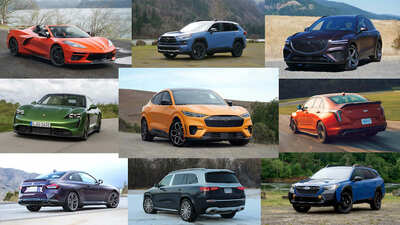Popular Cars That Have Risen the Most in Price
SEE ALSO 30 Years Of Expert New Car Reviews 1994-2023
 |
The increase in car prices has been particularly stark at the lower end of the market, and shoppers looking for good deals are finding fewer options available to them. The differences in premiums across price points are also apparent across vehicle makes and models.
Researchers calculated the difference between the current market price and the original pre-COVID price forecast for model year 2020 used vehicles currently for sale, then ranked models accordingly.
Below you’ll find a summary of the analysis—please feel free to
republish or use the findings in your own write-up. If you
choose to use the analysis, please link to the original report,
which includes a table with data on the 100 most popular used
vehicles with available data:
https://www.copilotsearch.com/
Popular Cars That Have Risen the Most in Price
The U.S. economy is now more than a year into a run of soaring inflation. According to data from the U.S. Bureau of Labor Statistics, the Consumer Price Index has experienced year-over-year inflation exceeding 5% every month dating back to May 2021, and year-over-year CPI growth topped 8% for three straight months this spring. Amid rising prices for nearly every consumer spending category, the U.S. Federal Reserve has begun to sharply increase interest rates to cool the economy. And some economic experts believe that these efforts to combat inflation have the U.S. headed for a recession.
One category that has been most dramatically affected by rising inflation is vehicles. While economists have debated the role of supply constraints and demand-side factors like aggressive government stimulus and high consumer spending in this inflationary period, the market for vehicles has been affected by both. COVID-related manufacturing shutdowns, labor shortages, and supply chain challenges have decreased the amount of new vehicles and increased competition for used cars. Simultaneously, consumers have been taking advantage of low interest rates, strong savings and investment returns earlier in the pandemic, and rising wages to finance major purchases including cars and trucks.
As a result, the CPI for new vehicles has risen by 16% since the beginning of 2020, while the CPI for used vehicles is up by more than 50% over the same span.
| |
However, there are some indications that inflation in the used vehicle market may have peaked. After reaching an all-time high in January 2022, used car prices fell for each of the next three months. While prices rose again slightly in May, the CPI for used vehicles remains below its peak from earlier this year. Auto industry experts have also recently reported an uptick in the number of vehicles available, relieving the supply pressures that have driven prices up.
| |
The increase in car prices has been particularly stark at the lower end of the market, and shoppers looking for good deals are finding fewer options available to them. For vehicles in the lowest quintile of car prices, the median car is currently priced 53.2% higher than forecasted pre-COVID. In contrast, the price premium in the highest quintile is 37.1%.
The differences in premiums across price points are also apparent across vehicle makes and models. Models from relatively affordable car manufacturers like Nissan, Kia, and Dodge have price increases that exceed overall averages, in some cases outpacing pre-COVID forecasts by more than two-thirds.
The data used in this study is from Copilot’s Price Pulse tool. To determine the popular cars that have risen the most in price, researchers calculated the difference between the current market price and the original pre-COVID price forecast. Only the 100 most popular used vehicles with available data were included in the study. The data shown reflects pricing data for model year 2020 used vehicles that are currently for sale.
Here are the popular cars that have risen the most in price.
| Model | Rank | Current price premium (%) | Current price premium ($) | Current price | Original price forecast |
|---|---|---|---|---|---|
| Nissan Altima | 1 | +68.2% | +$9,958 | $24,553 | $14,595 |
| Dodge Grand Caravan | 2 | +67.9% | +$10,940 | $27,062 | $16,122 |
| Dodge Journey | 3 | +63.1% | +$9,975 | $25,774 | $15,799 |
| Kia Forte | 4 | +59.4% | +$8,037 | $21,565 | $13,528 |
| Kia Optima | 5 | +57.3% | +$8,632 | $23,700 | $15,068 |
| Nissan Versa | 6 | +56.6% | +$7,051 | $19,501 | $12,450 |
| Nissan Sentra | 7 | +56.6% | +$8,461 | $23,410 | $14,949 |
| Chevrolet Impala | 8 | +56.3% | +$9,727 | $26,990 | $17,263 |
| Buick Encore | 9 | +56.0% | +$8,753 | $24,394 | $15,641 |
| Volkswagen Jetta | 10 | +54.0% | +$8,233 | $23,482 | $15,249 |
| Chevrolet Malibu | 11 | +53.7% | +$8,356 | $23,926 | $15,570 |
| Chevrolet Trax | 12 | +53.3% | +$8,103 | $23,306 | $15,203 |
| Ford Fusion | 13 | +53.1% | +$8,805 | $25,391 | $16,586 |
| Kia Sportage | 14 | +52.4% | +$9,393 | $27,326 | $17,933 |
| Kia Soul | 15 | +51.6% | +$7,516 | $22,080 | $14,564 |
| Top 100 models (median) | - | +40.6% | +$9,736 | $33,876 | $25,415 |
For more information, a detailed methodology, and complete
results, you can find the original report on CoPilot’s website:
https://www.copilotsearch.com/



